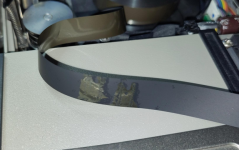GreyHairedDECfan
Experienced Member
As one of the few people on the planet who actually *USES* TK50's and 70's as primary backup media I have a few.... thoughts.
First, the weak point in these units is the capstains. Specifically the bearings have had their grease/oil dry out and as a result they drag on the tapes. More importantly the rear one is attached to a tachometer and it is CRITICAL that it does not drag or slip. If they drag they wear the tape and have massive problems with reading (as speed is sensed by that rear capstain)
So you need to remove them and either oil the bearings with light then medium viscosity watch oil (which will re-grease the dried grease) or press out and replace the bearings. If you spin them they should spin freely and spin for a bit with just finger flicks. If the drag or stop immediately they ain't gonna work.
Second problem is tape height is *super critical", controlled by the turns of the nuts on top of the capstains, and extremely difficult to set. However you can mark each nut and count the number of turns exactly to remove it. Make sure to note the position when it's at rest and just before it comes off the screw. Then turn the nuts back on the exact number of turns/fractions of a turn and the drive is in alignment. How can it be not
Note: Make sure you remember which nut goes on which spindle, as the marks will be at different places in the threads on the different nuts. Front nut to front capstain, rear to rear, and if there are washers keep the washers with the proper capstain.
When I get a new tape in I run several backups and verifies on it, then I rewind and lift up the head to check for any residue. If I see any residue I junk the tape, it's shedding. No residue=tape goes into the general population box. Keep an eye on the head and which tapes you use, if a tape starts throwing errors check to see if it's shedding, and if so junk that tape, clean the heads and capstains, then check the last tape you used and see if it's now shedding. Go back till you find good tapes, damage can spread from tape to tape.
With that, they're great. I can do things to my system and if I trash the disk I simply pop in an RX01 floppy with bru64k, then do a restore from the tape back to the disk. Never a problem. Also note, the TK70 controller is a lot better than the TK50 and can usually stream backups instead of the endless start/stop of the TK50. And a TQK70 can be used with a TK50 drive.
Have fun!
My hat is off to you for being able to get these to work. As someone who used these a lot back in the 1980s, I always considered them terrible. Had many problems with them even when the tapes and drives were brand new.

